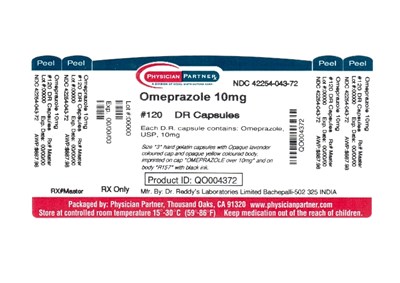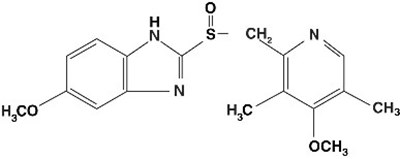Product Images Omeprazole
View Photos of Packaging, Labels & Appearance
- Chemical Structure - fac73e19 3809 4846 8abc f42a47c224ae 01
- Table 6 - fac73e19 3809 4846 8abc f42a47c224ae 02
- Table 7 - fac73e19 3809 4846 8abc f42a47c224ae 03
- Table 8 - fac73e19 3809 4846 8abc f42a47c224ae 04
- Graphic 1 - fac73e19 3809 4846 8abc f42a47c224ae 05
- Graphic 2 - fac73e19 3809 4846 8abc f42a47c224ae 06
- Graphic 3 - fac73e19 3809 4846 8abc f42a47c224ae 07
- Graphic 4 - fac73e19 3809 4846 8abc f42a47c224ae 08
- Graphic 5 - fac73e19 3809 4846 8abc f42a47c224ae 09
- Graphic 6 - fac73e19 3809 4846 8abc f42a47c224ae 10
- Omeprazole 10mg - fac73e19 3809 4846 8abc f42a47c224ae 11
- Omeprazole 20mg - fac73e19 3809 4846 8abc f42a47c224ae 12
Product Label Images
The following 12 images provide visual information about the product associated with Omeprazole NDC 42254-053 by Rebel Distributors Corp, such as packaging, labeling, and the appearance of the drug itself. This resource could be helpful for medical professionals, pharmacists, and patients seeking to verify medication information and ensure they have the correct product.
Table 6 - fac73e19 3809 4846 8abc f42a47c224ae 02

This text provides data on the success rates of eradicating H. pylori in patients treated with omeprazole, clarithromycin, and amoxicillin, compared to treatment with clarithromycin and amoxicillin only. The data is presented in the form of percentage of patients cured with 95% confidence intervals. The study included patients with confirmed duodenal ulcer disease and H. pylori infection at baseline. Patients who dropped out of the study due to adverse events related to the study drug were included in the analysis as treatment failures. The impact of eradication on ulcer recurrence in patients with a past history of ulcer has not been assessed. One study found omeprazole, clarithromycin, and amoxicillin to be significantly more effective than clarithromycin and amoxicillin only.*
Table 7 - fac73e19 3809 4846 8abc f42a47c224ae 03

This is a table showing the success rates of H. pylori eradication at 4 to 6 weeks through a per-protocol analysis. The table consists of different studies (Study 5, Study 6, and Study 7) and their respective eradication rates observed in patients treated with either a combination of omeprazole and clarithromycin or monotherapy with omeprazole or clarithromycin. The results are represented in percentages and their confidence intervals. There are also statistical comparisons between the different treatments.*
Table 8 - fac73e19 3809 4846 8abc f42a47c224ae 04

This document presents recurrence rates for duodenal ulcer based on the H. pylori eradication status. The results are presented as the percentage of patients with ulcer recurrence in studies conducted in the United States and internationally, six and twelve months post-treatment. The H. pylori eradication status was assessed at the same time point as ulcer recurrence. The studies include omeprazole and clarithromycin treatment arms as well as omeprazole treatment alone.*
Graphic 1 - fac73e19 3809 4846 8abc f42a47c224ae 05

This text provides information about the treatment of gastric ulcer using Omeprazole. The percentage of patients healed is given for all patients treated with Omeprazole 20mg once daily or Omeprazole 40mg once daily, and for those treated with a placebo. The results are displayed for week 4 and week 8. The text also includes statistical information about the significance of the results.*
Graphic 2 - fac73e19 3809 4846 8abc f42a47c224ae 06

This text presents the results of a study comparing the effectiveness of different treatments for gastric ulcers. The treatments evaluated were omeprazole 20 mg once daily, omeprazole 40 mg once daily and ranitidine 150 twice daily. The study shows the percentage of patients healed after 4 and 8 weeks of treatment. The results indicate that the percentage of patients healed was higher for omeprazole 40 mg once daily compared to ranitidine, and for omeprazole 40 mg once daily compared to omeprazole 20 mg once daily. The text includes symbols indicating statistical significance.*
Graphic 3 - fac73e19 3809 4846 8abc f42a47c224ae 07

The given text represents the results of a clinical trial comparing the efficacy of 20mg and 10mg of Omeprazole with Placebo. The data indicates that the use of 20mg Omeprazole has significantly improved the symptomatic outcomes for patients suffering from GERD and heartburn. However, the text lacks complete information to understand the methodologies of the trial and the context of the results.*
Graphic 4 - fac73e19 3809 4846 8abc f42a47c224ae 08

This appears to be a table showing the results of a study comparing the efficacy of two doses of omeprazole (20mg and 40mg) versus a placebo. The table shows the percentage of participants who experienced some sort of effect at 4 and 8 weeks. The results suggest that omeprazole had a statistically significant difference compared to placebo.*
Graphic 5 - fac73e19 3809 4846 8abc f42a47c224ae 09

This is a study analysis comparing the effectiveness of omeprazole 20mg once daily versus omeprazole 20mg for 3 consecutive days per week or placebo for endoscopic remission after 6 months. The study involved 138 patients for omeprazole once daily, 137 for omeprazole 3 days per week, and 131 for placebo. The study showed that omeprazole once daily was significantly more effective than omeprazole 3 days per week or placebo. The percentage of patients in endoscopic remission at 6 months was 70% for omeprazole once daily, 34% for omeprazole 3 days per week, and 11% for placebo.*
Graphic 6 - fac73e19 3809 4846 8abc f42a47c224ae 10

This text describes a study on the effectiveness of different dosages and types of medication in achieving endoscopic remission. The study compares the results of three groups, one taking 20mg of Omeprazole once daily (131 participants), another taking 10mg of Omeprazole once daily (133 participants), and the third taking 150mg of Ranitidine twice daily (128 participants). The percentage of participants who achieved endoscopic remission after 12 months was recorded for each group, with the group taking 20mg of Omeprazole once daily showing the highest percentage of remission. The text also includes statistical significance values for the comparisons between the groups.*
Omeprazole 10mg - fac73e19 3809 4846 8abc f42a47c224ae 11

This is a medication label for Omeprazole 10mg DR capsules manufactured by Dr. Reddy's Laboratories Limited, with a prescription number of Q0004372. The capsules come in a pack of 120 and should be stored at a controlled room temperature of 15-30°C. The label also contains instructions to keep the medication out of the reach of children. There is a name (S Efrith) written in black ink on the label, and the name Capetid and some numbers are visible.*
Omeprazole 20mg - fac73e19 3809 4846 8abc f42a47c224ae 12

This is a description of a medication called Omeprazole 20mg DR capsules. Each capsule contains 20mg of omeprazole USP. The NDC code for this product is 4225408372, and the product ID is QO005372CA. This medication is only available by prescription, and it was manufactured by Dr. Reddy's Laboratories Limited in India. The medication should be stored at room temperature, between 15°C and 30°C. Packaging was done by Physician Partner, Thousand. There is no additional information about the medication's uses or effects.*
* The product label images have been analyzed using a combination of traditional computing and machine learning techniques. It should be noted that the descriptions provided may not be entirely accurate as they are experimental in nature. Use the information in this page at your own discretion and risk.
